外研版必修五Module 1 British and American English Vocabulary 课件(39张PPT)
文档属性
| 名称 | 外研版必修五Module 1 British and American English Vocabulary 课件(39张PPT) |  | |
| 格式 | pptx | ||
| 文件大小 | 3.8MB | ||
| 资源类型 | 教案 | ||
| 版本资源 | 外研版 | ||
| 科目 | 英语 | ||
| 更新时间 | 2022-10-26 21:39:42 | ||
图片预览

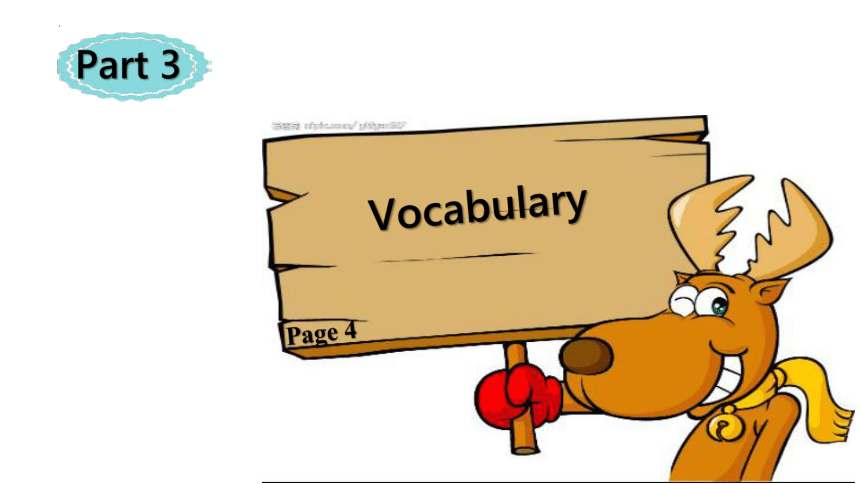
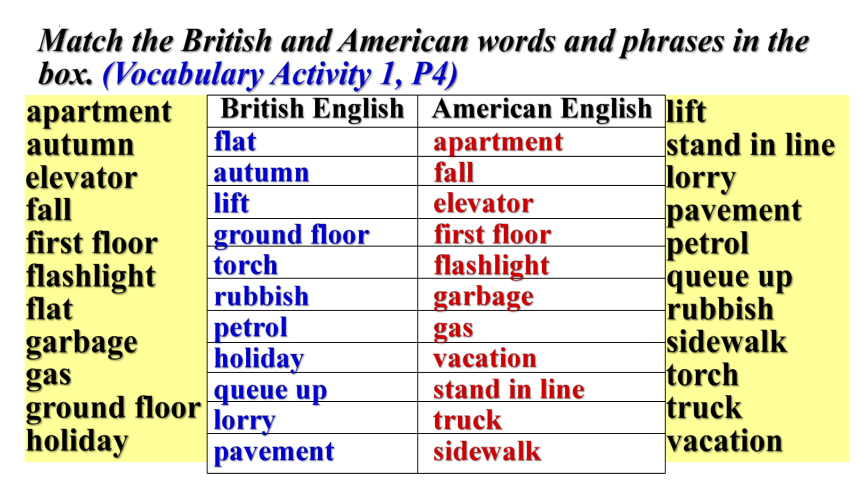
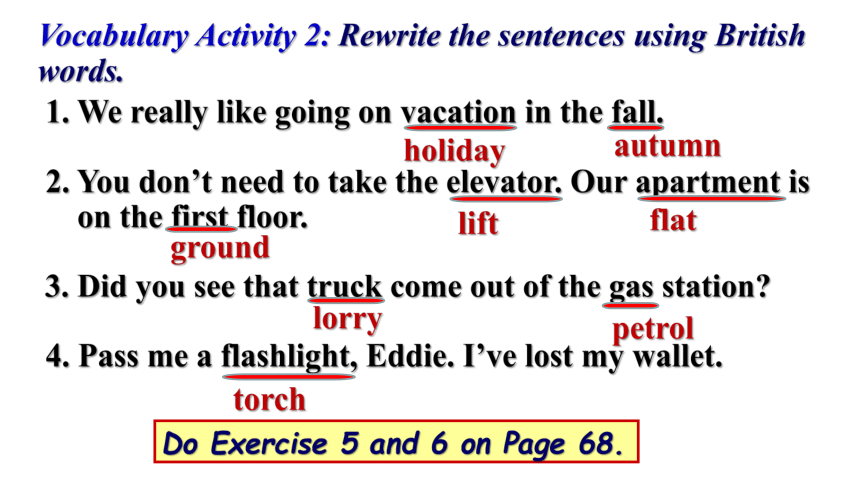
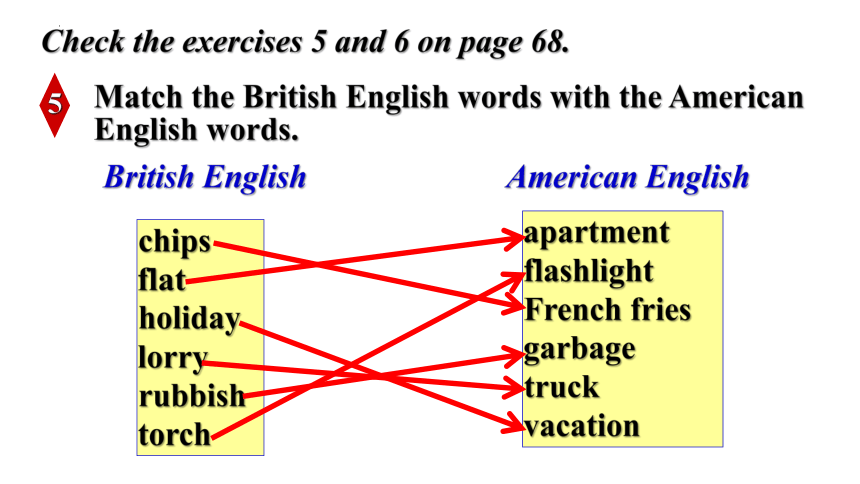
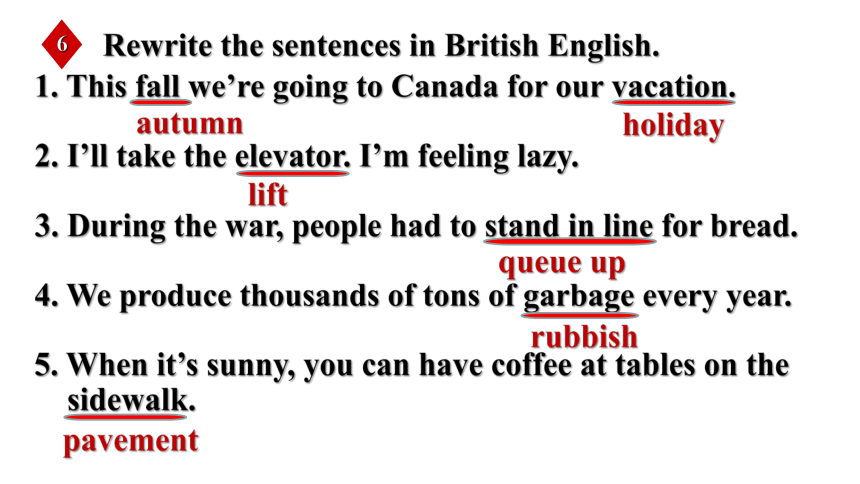
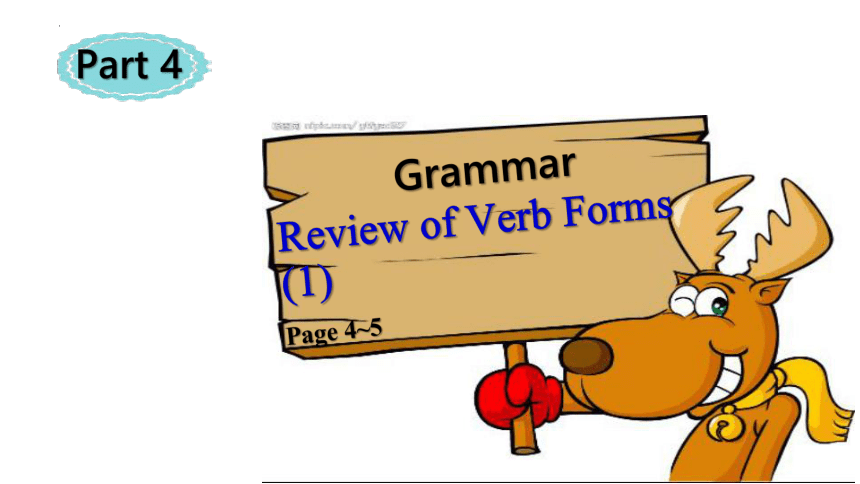
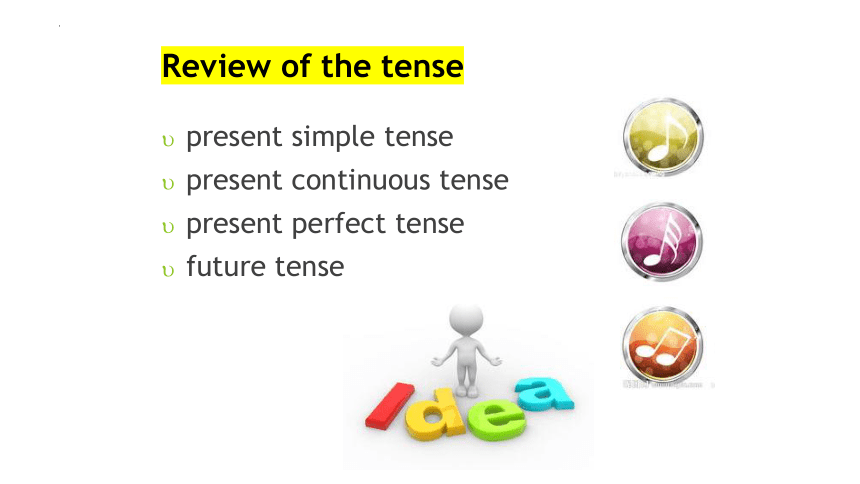
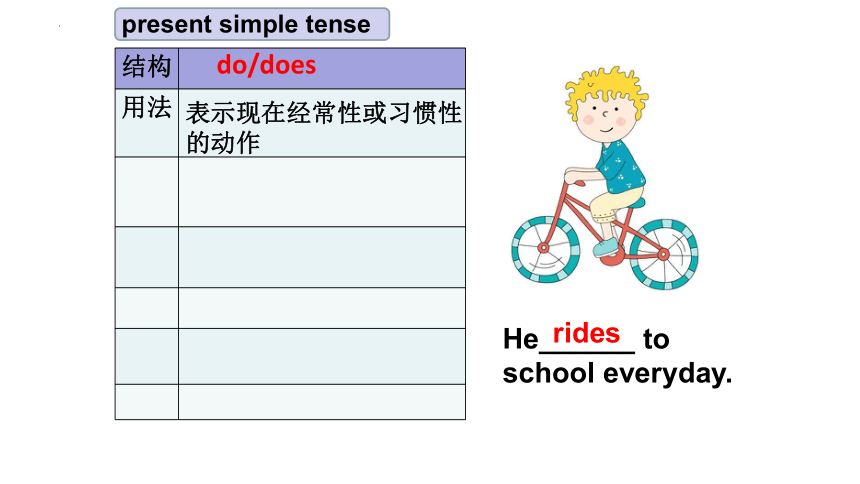
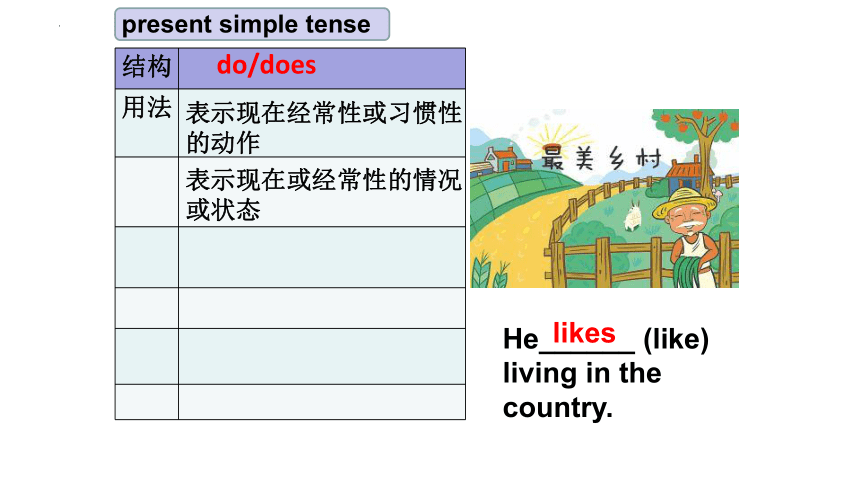
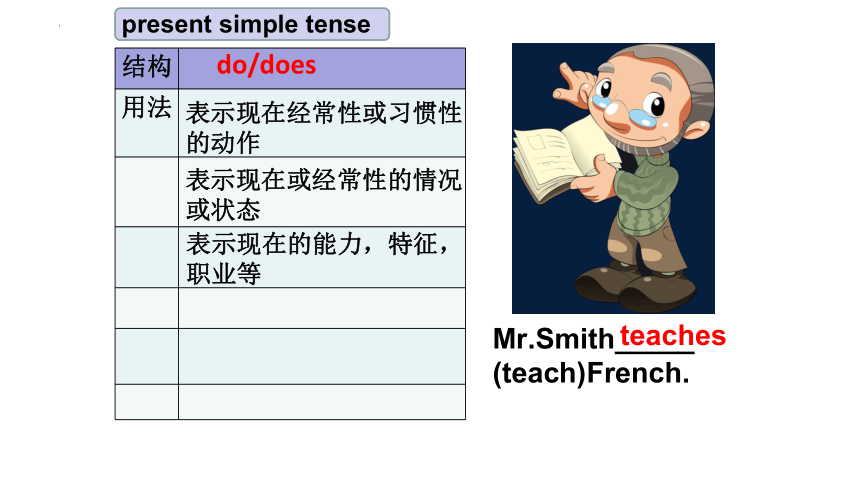
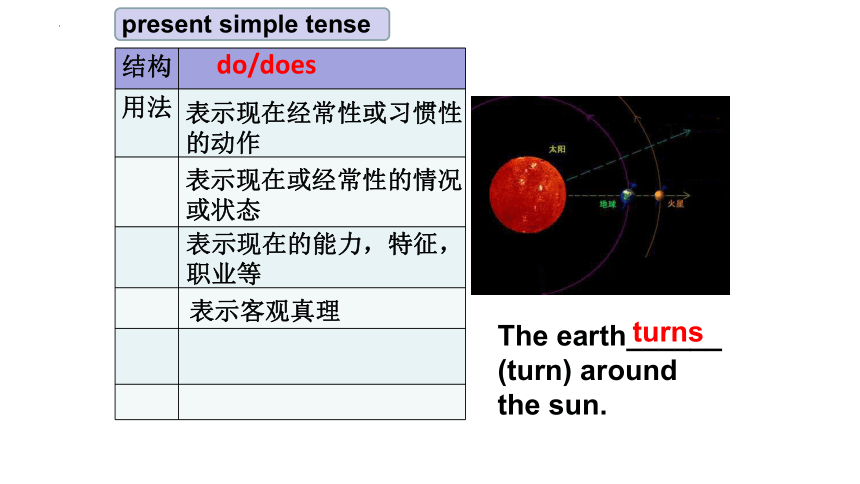
文档简介
(共39张PPT)
Book 5
Module 1
British and American English
Part 3
Page 4
Vocabulary
Match the British and American words and phrases in the box. (Vocabulary Activity 1, P4)
apartment autumn elevator fall
first floor flashlight flat garbage gas
ground floor holiday
lift
stand in line lorry pavement petrol
queue up rubbish sidewalk torch
truck vacation
British English American English
flat
autumn
lift
ground floor
torch
rubbish
petrol
holiday
queue up
lorry
pavement
apartment
fall
elevator
first floor
flashlight
garbage
gas
vacation
stand in line
truck
sidewalk
Vocabulary Activity 2: Rewrite the sentences using British words.
1. We really like going on vacation in the fall.
2. You don’t need to take the elevator. Our apartment is
on the first floor.
3. Did you see that truck come out of the gas station
4. Pass me a flashlight, Eddie. I’ve lost my wallet.
holiday
autumn
lift
flat
ground
lorry
petrol
torch
Do Exercise 5 and 6 on Page 68.
Check the exercises 5 and 6 on page 68.
5
Match the British English words with the American English words.
British English
American English
chips
flat
holiday
lorry
rubbish
torch
apartment
flashlight
French fries
garbage
truck
vacation
6
Rewrite the sentences in British English.
1. This fall we’re going to Canada for our vacation.
2. I’ll take the elevator. I’m feeling lazy.
3. During the war, people had to stand in line for bread.
4. We produce thousands of tons of garbage every year.
5. When it’s sunny, you can have coffee at tables on the
sidewalk.
autumn
holiday
lift
rubbish
queue up
pavement
Part 4
Page 4~5
Grammar
Review of Verb Forms (1)
Review of the tense
present simple tense
present continuous tense
present perfect tense
future tense
present simple tense
结构
用法
do/does
He______ to school everyday.
表示现在经常性或习惯性
的动作
rides
present simple tense
结构
用法
do/does
He______ (like) living in the country.
表示现在经常性或习惯性
的动作
表示现在或经常性的情况
或状态
likes
present simple tense
结构
用法
do/does
Mr.Smith_____ (teach)French.
表示现在经常性或习惯性
的动作
表示现在或经常性的情况
或状态
表示现在的能力,特征,
职业等
teaches
present simple tense
结构
用法
do/does
The earth______
(turn) around the sun.
表示现在经常性或习惯性
的动作
表示现在或经常性的情况
或状态
表示客观真理
表示现在的能力,特征,
职业等
turns
present simple tense
结构
用法
do/does
I will write to her when I ______(have) time.
表示现在经常性或习惯性
的动作
表示现在或经常性的情况
或状态
主将从现
表示现在的能力,特征,
职业等
表示客观真理
have
present simple tense
结构
用法
do/does
The train______ (leave)at 17:49.
表示现在经常性或习惯性
的动作
表示现在或经常性的情况
或状态
主将从现
表示现在的能力,特征,
职业等
表示按照规定,时间表要
发生的动作。
leaves
表示客观真理
1224/1221 普快/新空调车 广州东→成都 17:49 - 10:36
1271/1274 普快/普通车 杭州→成都 13:04 - 16:40
1312/1313 普快/普通车 天津→成都 15:13 - 06:19
Timetable
present continuous tense
结构
用法
am/is/are + doing
表示说话正在进行的动作
We___________
(have) English lesson now.
are having
present continuous tense
结构
用法
am/is/are + doing
表示说话正在进行的动作
少数来去动词:go/ come/ leave/arrive/return/begin等用现在进行时表示预计即将发生的动作
John___________
(come) here next Friday.
is coming
present continuous tense
结构
用法
am/is/are + doing
表示说话正在进行的动作
常与:always/ forever/ constantly/ all the time连用表示反复发生或习惯动作,常表示不满,抱怨或赞赏。
少数来去动词:go/ come/ leave/arrive/return/begin等用现在进行时表示预计即将发生的动作
Jack ___ always
_______ (laugh)at others.
is
laughing
present perfect tense
结构
用法
have/ has done
表示过去发生仍对现在有影响
China _________ (make)great progress in science and technology.
has made
present perfect tense
结构
用法
have/ has done
表示过去发生仍对现在有影响
表示从过去开始而延续至今的动作或状态
We _________ (be) good friends since our middle school days.
has been
present perfect tense
结构
用法
have/ has done
表示过去发生仍对现在有影响
表示从过去开始而延续至今的动作或状态
在时间/条件状语从句中,表示将来某个时刻之间就已经完成的动作
I’ll tell you my opinion after I _________ (read) your article.
have read
future tense
结构
用法
对将来的一种推测
will/ shall do
In the year 2100, people__________ holidays in space.
will have
is going to have
future tense
结构
用法
对将来的一种推测
will/ shall do
主将从现
man will not survive.
Will man survive
will do talks about
_______________________________________________.
a prediction
an arrangement for the near future
a future time reference(参照) in a conditional(条件的) sentence
If pollution continues,__________________.
future tense
结构
用法
Look —it is going to rain.
am/ is/ are going to talks about________________________.
a prediction
an intention
a timetable
an arrangement for the near future
a future you can “see” now
a future time reference(参照) in a conditional(条件的) sentence
am/is/ are + doing
a future you can “see” now
Match the sentences 1 — 6 with the meanings A— F.
The British say Have you got… While Americans prefer Do you have…
Many factors have influenced American pronunciation
Some experts believe that the two varieties are moving closer together.
Some people now believe that British English will disappear.
In the future, there are going to be many “Englishes”
Look! The man is filling his automobile with gas.
A.A changing situation
B. An event which is happening now or around now.
C. a possible future
D. A certain future
E. Past events which have an effect on the present
F. An everyday event.
Finish exercises RELATED TO TENSES on the students book
Review the usage of since and for and do Activity 3 on page 5.
Activity 2: Complete the sentences with the correct form of the verbs.
1. All languages ________ (change) over a period of time.
2. English _______________ (develop) very rapidly.
3. How many people ________ (speak) Chinese
4. I ___________ (not think) American English is very
different from British English.
5. Millions of people ______ (watch) satellite TV every day.
6. The percentage of non-English web pages __________
(grow).
7. What languages _____ people ______ (study) in China
8. What ____ you _________ (study) this year
change
is developing
speak
don't think
watch
is growing
do
study
are
studying
Activity 4. Complete the sentences with the correct verb forms.
1. What ____ you _____ tonight Can you let me know
A. do; do B. will; do C. are; doing
2. Let’s watch the news on CNN. It ____ at eight o’clock.
A. will start B. starts C. is starting
3. The prime minister ____ an important announcement
at the moment.
A. is making B. will make C. is going to make
表纯粹的将来
时刻表上的安排
说话时正在进行的动作
4. Many of the world’s languages ______ in the next
hundred years.
A. are disappearing B. will disappear C. disappear
5. One day there _____ easier ways of learning a foreign
language.
A. will be B. are going to be C. are
6. I ____ linguistics when I go to university.
A. am studying B. am going to study C. study
对将来进行预测
对将来进行预测
说话之前就有的打算
Do activity 5. Complete the sentence in your own words.
In the future, English _____________.
Eg.
will be spoken very differently in different parts of the world.
will become even more important in the world than it is today.
will become less important in the world than it is today.
will not be the most used language on the Internet.
since / for用法归纳
现在完成时常与since和for构成的时间状语连用,现将它们的主要用法归纳如下:
1. since
+从句
+表时间点的名词
conj. 表示“自从过去某一时间点开始到现在”,主句常用现在完成时,从句用一般过去时。
prep. 不能接时间段名词
◆注意下面句型的正确理解:
It’s two years since he became a teacher.
It’s two years since he was a teacher.
他不当老师有两年了。
他当老师两年了。
2. for +时间段名词:
E.g. We have studied English for two years.
They have known each other for five years.
prep. 表时间的长度,后面不可以接时间点。
★注意:
①在肯定句中,非延续性动词的现在完成时不能和
since / for构成的时间状语连用,但在否定句中却可以。
② “for +时间段”并不一定和现在完成时连用。它还可以
和一般过去时、过去完成时、过去完成进行时、现在
完成进行时等连用,要视语境而定。
Activity 3: Complete the sentences with since and for.
1. English grammar has not changed much ______ the time of Shakespeare.
2. The American spelling system has existed _____ about 20 years.
3. I have been studying English ______ I was in primary school.
4. We have an American teacher. He has been here _____ January.
5. CNN has been on the air _____ more than twenty years.
6. David has worked for CNN _____ the year 2000.
since
for
since
since
for
since
Decide right or wrong and then correct the wrong.
1) I have not received his letter for two months.
2) He has bought the dictionary for two weeks.
3) My father has joined the Party for ten years.
4) She has left since two years ago.
√
×
had
been in
been away
×
×
Choose the best answer.
1) - I’m sure Andrew will win the first prize in
the final.
- I think so. He ____ for it for months. (08江苏)
A. is preparing B. was preparing
C. had been preparing D. has been preparing
2) -Did Alan enjoy seeing his old friends
yesterday
-Yes, he did. He ____ his old friends for a long
time. (07重庆)
A. didn’t see B. wouldn’t see
C. hasn’t seen D. hadn’t seen
3) The crazy fans _____ patiently for two hours,
and they would wait till the movie star
arrived. (04重庆)
A. were waiting B. had been waiting
C. had waited D. would wait
4) He ____ football regularly for many years
when he was young. (08天津)
A. was playing B. played
C. has played D. had played
1. 一般现在时的主要用法
1)表示________________的动作或主语_________状态
或性质、特征、能力等。通常与其连用的时间状语有
always / usually / often /sometimes /now /seldom / every
day / once a month / at present等, 有时要根据上下文的
语境进行判断。
2)表示____________________。
3)在________________________等状语从句中表示____。
4)一些表“起始、位移”的动词如:begin, come, leave, go,
arrive, start, stop, return, take off等,还可用一般现在
时表示 _______________________将要发生的事。
5)在完全倒装句中一般现在时可表示__________的动作。
经常性、习惯性
现在的
普遍真理或客观事实
时间、条件、让步、方式
将来
日程表或时刻表上安排的
正在进行的
summary:
2. 一般将来时主要表达法及区别
1) _____(第一人称可用_____)主要表示纯粹的将来、说话
过程中临时决定将要做某事、事物固有的属性或必然
趋势以及对将来进行预测。
2)____________表示有迹象表明的将来以及说话之前已决
定或准备好最近将要做某事。
3)______________表示“马上就要做某事”,句中不能带
表将来的时间状语。
4)________表示计划、安排、征求意见、命令或注定要发
生的动作,也可以用于条件、时间等从句中表将来。
5)动词的___________主要用于时间、条件等状语从句中
表将来或时刻表、日程表上的安排。
6)动词的___________也可用来表示按计划或安排最近将
要发生某事。
will
shall
be going to
be about to do
be to do
一般现在时
现在进行时
3. 现在进行时的主要用法
1)表示__________________动作,在句中往往有now / at
present / just now 等时间状语或是象Look! Listen!等提示
词语,有的则是通过上下文暗示某动作正在进行。
2)现在进行时还可以表示_______________,但说话时不一
定正在进行的动作。
3)现在进行时和频度的副词always, constantly, forever, 等连
用, 表示_______________________。
4)现在进行时还可以用于come, leave, go, arrive, start, stop,
return, finish, take off, fly等表位移的动词, 表示
__________________要发生的动作。
5)非延续性动词die, stop, start, finish, approach等的现在进
行时一般表示__________________。
说话时正在进行的
现阶段在进行
赞扬/不满/厌恶等感彩
计划、安排、打算
很快就要发生的动作
1)现在完成时表示说话之前已经完成的某一动作对____造成的影响或结果,也可表示过去已经开始, 持续到____(可能还会继续进行下去)的动作或状态。常带有till now,up to now, so far, in the past / last ... years, for ..., since ..., already, yet, recently, just 等时间状语。
2)现在完成时还可以用在时间或条件状语从句中, 代替___________,表示将来某时已完成的动作。
3) 注意:
have /has gone to
have /has been to
现在
现在
将来完成时
已经去某地了
曾经去过某地
4. 现在完成时
Book 5
Module 1
British and American English
Part 3
Page 4
Vocabulary
Match the British and American words and phrases in the box. (Vocabulary Activity 1, P4)
apartment autumn elevator fall
first floor flashlight flat garbage gas
ground floor holiday
lift
stand in line lorry pavement petrol
queue up rubbish sidewalk torch
truck vacation
British English American English
flat
autumn
lift
ground floor
torch
rubbish
petrol
holiday
queue up
lorry
pavement
apartment
fall
elevator
first floor
flashlight
garbage
gas
vacation
stand in line
truck
sidewalk
Vocabulary Activity 2: Rewrite the sentences using British words.
1. We really like going on vacation in the fall.
2. You don’t need to take the elevator. Our apartment is
on the first floor.
3. Did you see that truck come out of the gas station
4. Pass me a flashlight, Eddie. I’ve lost my wallet.
holiday
autumn
lift
flat
ground
lorry
petrol
torch
Do Exercise 5 and 6 on Page 68.
Check the exercises 5 and 6 on page 68.
5
Match the British English words with the American English words.
British English
American English
chips
flat
holiday
lorry
rubbish
torch
apartment
flashlight
French fries
garbage
truck
vacation
6
Rewrite the sentences in British English.
1. This fall we’re going to Canada for our vacation.
2. I’ll take the elevator. I’m feeling lazy.
3. During the war, people had to stand in line for bread.
4. We produce thousands of tons of garbage every year.
5. When it’s sunny, you can have coffee at tables on the
sidewalk.
autumn
holiday
lift
rubbish
queue up
pavement
Part 4
Page 4~5
Grammar
Review of Verb Forms (1)
Review of the tense
present simple tense
present continuous tense
present perfect tense
future tense
present simple tense
结构
用法
do/does
He______ to school everyday.
表示现在经常性或习惯性
的动作
rides
present simple tense
结构
用法
do/does
He______ (like) living in the country.
表示现在经常性或习惯性
的动作
表示现在或经常性的情况
或状态
likes
present simple tense
结构
用法
do/does
Mr.Smith_____ (teach)French.
表示现在经常性或习惯性
的动作
表示现在或经常性的情况
或状态
表示现在的能力,特征,
职业等
teaches
present simple tense
结构
用法
do/does
The earth______
(turn) around the sun.
表示现在经常性或习惯性
的动作
表示现在或经常性的情况
或状态
表示客观真理
表示现在的能力,特征,
职业等
turns
present simple tense
结构
用法
do/does
I will write to her when I ______(have) time.
表示现在经常性或习惯性
的动作
表示现在或经常性的情况
或状态
主将从现
表示现在的能力,特征,
职业等
表示客观真理
have
present simple tense
结构
用法
do/does
The train______ (leave)at 17:49.
表示现在经常性或习惯性
的动作
表示现在或经常性的情况
或状态
主将从现
表示现在的能力,特征,
职业等
表示按照规定,时间表要
发生的动作。
leaves
表示客观真理
1224/1221 普快/新空调车 广州东→成都 17:49 - 10:36
1271/1274 普快/普通车 杭州→成都 13:04 - 16:40
1312/1313 普快/普通车 天津→成都 15:13 - 06:19
Timetable
present continuous tense
结构
用法
am/is/are + doing
表示说话正在进行的动作
We___________
(have) English lesson now.
are having
present continuous tense
结构
用法
am/is/are + doing
表示说话正在进行的动作
少数来去动词:go/ come/ leave/arrive/return/begin等用现在进行时表示预计即将发生的动作
John___________
(come) here next Friday.
is coming
present continuous tense
结构
用法
am/is/are + doing
表示说话正在进行的动作
常与:always/ forever/ constantly/ all the time连用表示反复发生或习惯动作,常表示不满,抱怨或赞赏。
少数来去动词:go/ come/ leave/arrive/return/begin等用现在进行时表示预计即将发生的动作
Jack ___ always
_______ (laugh)at others.
is
laughing
present perfect tense
结构
用法
have/ has done
表示过去发生仍对现在有影响
China _________ (make)great progress in science and technology.
has made
present perfect tense
结构
用法
have/ has done
表示过去发生仍对现在有影响
表示从过去开始而延续至今的动作或状态
We _________ (be) good friends since our middle school days.
has been
present perfect tense
结构
用法
have/ has done
表示过去发生仍对现在有影响
表示从过去开始而延续至今的动作或状态
在时间/条件状语从句中,表示将来某个时刻之间就已经完成的动作
I’ll tell you my opinion after I _________ (read) your article.
have read
future tense
结构
用法
对将来的一种推测
will/ shall do
In the year 2100, people__________ holidays in space.
will have
is going to have
future tense
结构
用法
对将来的一种推测
will/ shall do
主将从现
man will not survive.
Will man survive
will do talks about
_______________________________________________.
a prediction
an arrangement for the near future
a future time reference(参照) in a conditional(条件的) sentence
If pollution continues,__________________.
future tense
结构
用法
Look —it is going to rain.
am/ is/ are going to talks about________________________.
a prediction
an intention
a timetable
an arrangement for the near future
a future you can “see” now
a future time reference(参照) in a conditional(条件的) sentence
am/is/ are + doing
a future you can “see” now
Match the sentences 1 — 6 with the meanings A— F.
The British say Have you got… While Americans prefer Do you have…
Many factors have influenced American pronunciation
Some experts believe that the two varieties are moving closer together.
Some people now believe that British English will disappear.
In the future, there are going to be many “Englishes”
Look! The man is filling his automobile with gas.
A.A changing situation
B. An event which is happening now or around now.
C. a possible future
D. A certain future
E. Past events which have an effect on the present
F. An everyday event.
Finish exercises RELATED TO TENSES on the students book
Review the usage of since and for and do Activity 3 on page 5.
Activity 2: Complete the sentences with the correct form of the verbs.
1. All languages ________ (change) over a period of time.
2. English _______________ (develop) very rapidly.
3. How many people ________ (speak) Chinese
4. I ___________ (not think) American English is very
different from British English.
5. Millions of people ______ (watch) satellite TV every day.
6. The percentage of non-English web pages __________
(grow).
7. What languages _____ people ______ (study) in China
8. What ____ you _________ (study) this year
change
is developing
speak
don't think
watch
is growing
do
study
are
studying
Activity 4. Complete the sentences with the correct verb forms.
1. What ____ you _____ tonight Can you let me know
A. do; do B. will; do C. are; doing
2. Let’s watch the news on CNN. It ____ at eight o’clock.
A. will start B. starts C. is starting
3. The prime minister ____ an important announcement
at the moment.
A. is making B. will make C. is going to make
表纯粹的将来
时刻表上的安排
说话时正在进行的动作
4. Many of the world’s languages ______ in the next
hundred years.
A. are disappearing B. will disappear C. disappear
5. One day there _____ easier ways of learning a foreign
language.
A. will be B. are going to be C. are
6. I ____ linguistics when I go to university.
A. am studying B. am going to study C. study
对将来进行预测
对将来进行预测
说话之前就有的打算
Do activity 5. Complete the sentence in your own words.
In the future, English _____________.
Eg.
will be spoken very differently in different parts of the world.
will become even more important in the world than it is today.
will become less important in the world than it is today.
will not be the most used language on the Internet.
since / for用法归纳
现在完成时常与since和for构成的时间状语连用,现将它们的主要用法归纳如下:
1. since
+从句
+表时间点的名词
conj. 表示“自从过去某一时间点开始到现在”,主句常用现在完成时,从句用一般过去时。
prep. 不能接时间段名词
◆注意下面句型的正确理解:
It’s two years since he became a teacher.
It’s two years since he was a teacher.
他不当老师有两年了。
他当老师两年了。
2. for +时间段名词:
E.g. We have studied English for two years.
They have known each other for five years.
prep. 表时间的长度,后面不可以接时间点。
★注意:
①在肯定句中,非延续性动词的现在完成时不能和
since / for构成的时间状语连用,但在否定句中却可以。
② “for +时间段”并不一定和现在完成时连用。它还可以
和一般过去时、过去完成时、过去完成进行时、现在
完成进行时等连用,要视语境而定。
Activity 3: Complete the sentences with since and for.
1. English grammar has not changed much ______ the time of Shakespeare.
2. The American spelling system has existed _____ about 20 years.
3. I have been studying English ______ I was in primary school.
4. We have an American teacher. He has been here _____ January.
5. CNN has been on the air _____ more than twenty years.
6. David has worked for CNN _____ the year 2000.
since
for
since
since
for
since
Decide right or wrong and then correct the wrong.
1) I have not received his letter for two months.
2) He has bought the dictionary for two weeks.
3) My father has joined the Party for ten years.
4) She has left since two years ago.
√
×
had
been in
been away
×
×
Choose the best answer.
1) - I’m sure Andrew will win the first prize in
the final.
- I think so. He ____ for it for months. (08江苏)
A. is preparing B. was preparing
C. had been preparing D. has been preparing
2) -Did Alan enjoy seeing his old friends
yesterday
-Yes, he did. He ____ his old friends for a long
time. (07重庆)
A. didn’t see B. wouldn’t see
C. hasn’t seen D. hadn’t seen
3) The crazy fans _____ patiently for two hours,
and they would wait till the movie star
arrived. (04重庆)
A. were waiting B. had been waiting
C. had waited D. would wait
4) He ____ football regularly for many years
when he was young. (08天津)
A. was playing B. played
C. has played D. had played
1. 一般现在时的主要用法
1)表示________________的动作或主语_________状态
或性质、特征、能力等。通常与其连用的时间状语有
always / usually / often /sometimes /now /seldom / every
day / once a month / at present等, 有时要根据上下文的
语境进行判断。
2)表示____________________。
3)在________________________等状语从句中表示____。
4)一些表“起始、位移”的动词如:begin, come, leave, go,
arrive, start, stop, return, take off等,还可用一般现在
时表示 _______________________将要发生的事。
5)在完全倒装句中一般现在时可表示__________的动作。
经常性、习惯性
现在的
普遍真理或客观事实
时间、条件、让步、方式
将来
日程表或时刻表上安排的
正在进行的
summary:
2. 一般将来时主要表达法及区别
1) _____(第一人称可用_____)主要表示纯粹的将来、说话
过程中临时决定将要做某事、事物固有的属性或必然
趋势以及对将来进行预测。
2)____________表示有迹象表明的将来以及说话之前已决
定或准备好最近将要做某事。
3)______________表示“马上就要做某事”,句中不能带
表将来的时间状语。
4)________表示计划、安排、征求意见、命令或注定要发
生的动作,也可以用于条件、时间等从句中表将来。
5)动词的___________主要用于时间、条件等状语从句中
表将来或时刻表、日程表上的安排。
6)动词的___________也可用来表示按计划或安排最近将
要发生某事。
will
shall
be going to
be about to do
be to do
一般现在时
现在进行时
3. 现在进行时的主要用法
1)表示__________________动作,在句中往往有now / at
present / just now 等时间状语或是象Look! Listen!等提示
词语,有的则是通过上下文暗示某动作正在进行。
2)现在进行时还可以表示_______________,但说话时不一
定正在进行的动作。
3)现在进行时和频度的副词always, constantly, forever, 等连
用, 表示_______________________。
4)现在进行时还可以用于come, leave, go, arrive, start, stop,
return, finish, take off, fly等表位移的动词, 表示
__________________要发生的动作。
5)非延续性动词die, stop, start, finish, approach等的现在进
行时一般表示__________________。
说话时正在进行的
现阶段在进行
赞扬/不满/厌恶等感彩
计划、安排、打算
很快就要发生的动作
1)现在完成时表示说话之前已经完成的某一动作对____造成的影响或结果,也可表示过去已经开始, 持续到____(可能还会继续进行下去)的动作或状态。常带有till now,up to now, so far, in the past / last ... years, for ..., since ..., already, yet, recently, just 等时间状语。
2)现在完成时还可以用在时间或条件状语从句中, 代替___________,表示将来某时已完成的动作。
3) 注意:
have /has gone to
have /has been to
现在
现在
将来完成时
已经去某地了
曾经去过某地
4. 现在完成时
